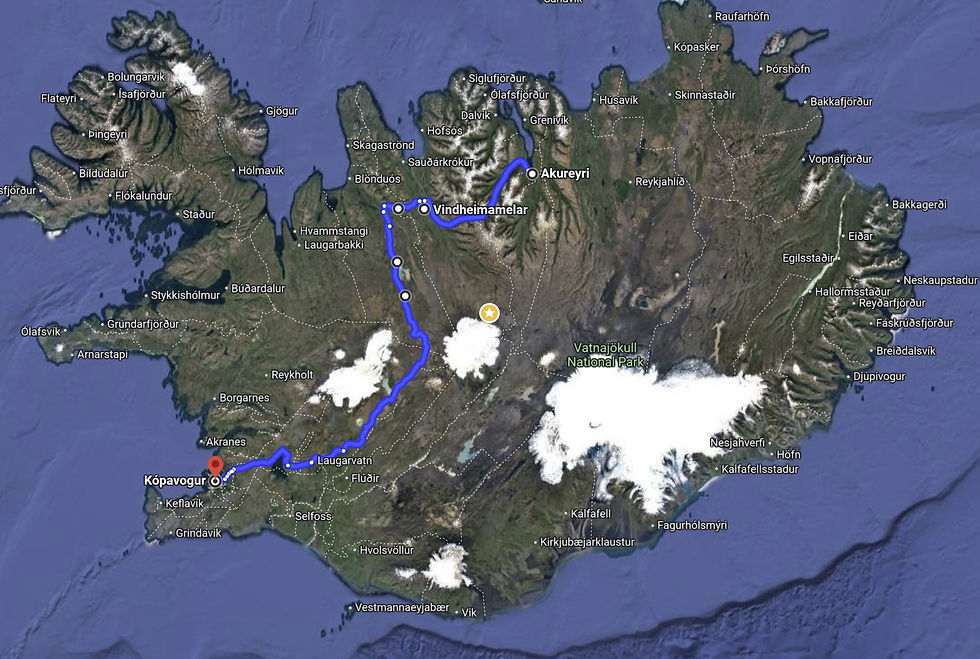
Approximate route

We leave the nice, cosy apartment this morning and head off into the rain. We would be telling an untruth if we said we’re not disappointed that the weather hasn’t been better so far, but we’re not leaving Iceland for a while yet and the weather forecast has shown it to be better in the south so we’re still optimistic and of course, we now have our ponchos!
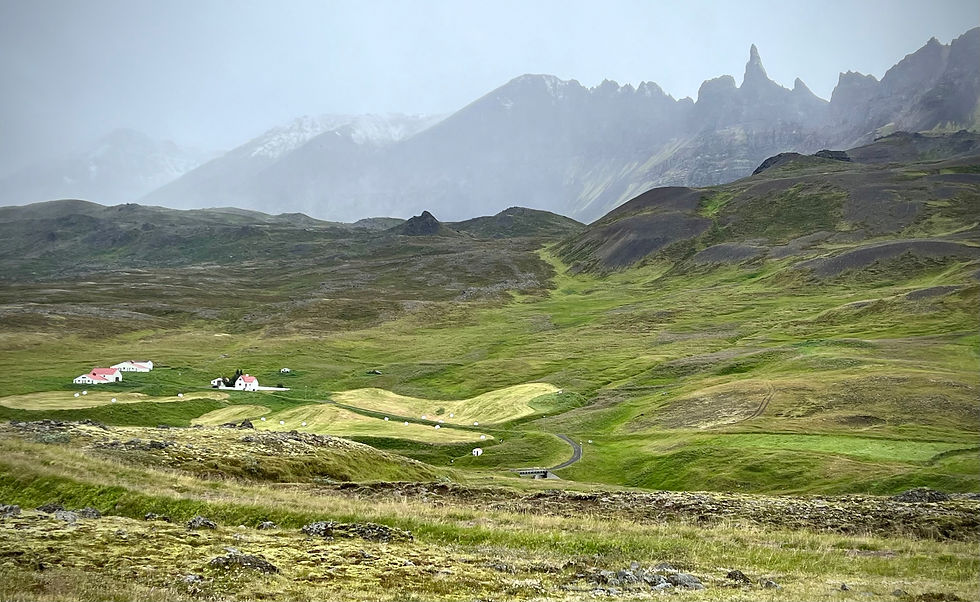
We travel through a valley edged by spectacular mountains; the scenery is so big compared to what we’re used to at home, everything is so dramatic; there’s nothing mundane about any of the landscapes in Iceland.

As we travel on we are horrified as the temperature drops to 2 degrees and it starts to snow, maybe our optimism has been misplaced and of course we are camping again tonight!
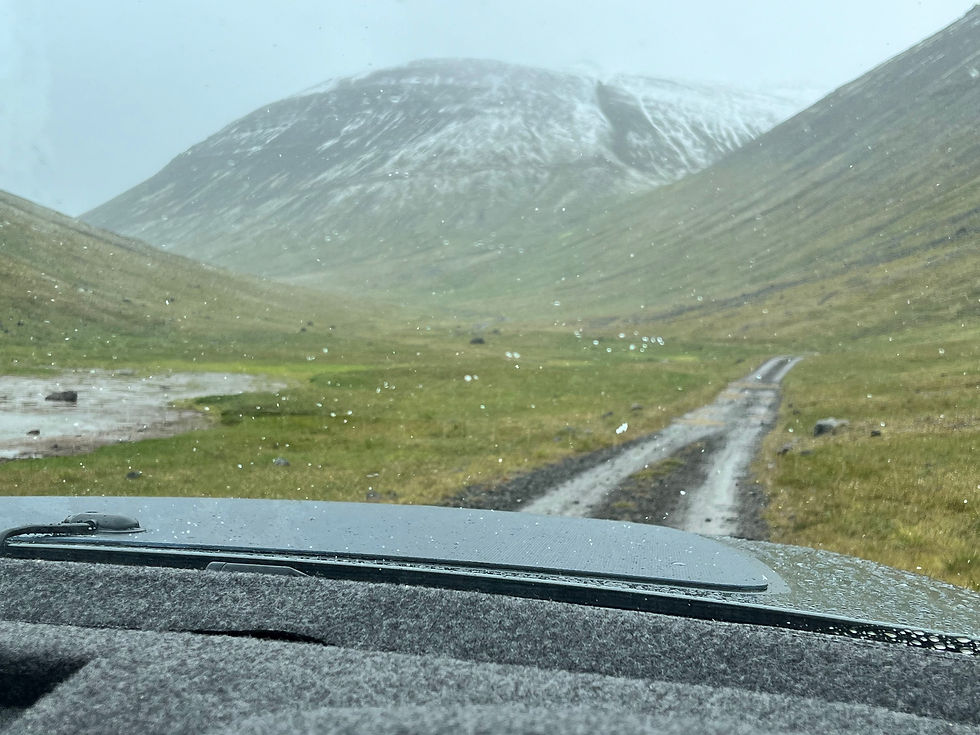
Our route today takes us through the mountains and back into the interior, or Highlands as it is known, which is essentially a barren upland plateau, described as the last true wilderness of Europe.

The routes through the interior were developed in Viking times as short cuts enabling people to get to the law-making sessions in Thingvellir. The Ring Road, Iceland’s major road which encircles the island, has meant that the need for roads across the interior has fallen away and although these roads do still exist, they are unsealed and in many cases, they are very rough indeed with no bridges over the rivers. They are known as F Roads.

There is an F Road, the F35, which would take us all the way to our next destination but we read that it is pretty tame, the rivers have all been bridged and it is actually manageable for ordinary two-wheel-drive cars.
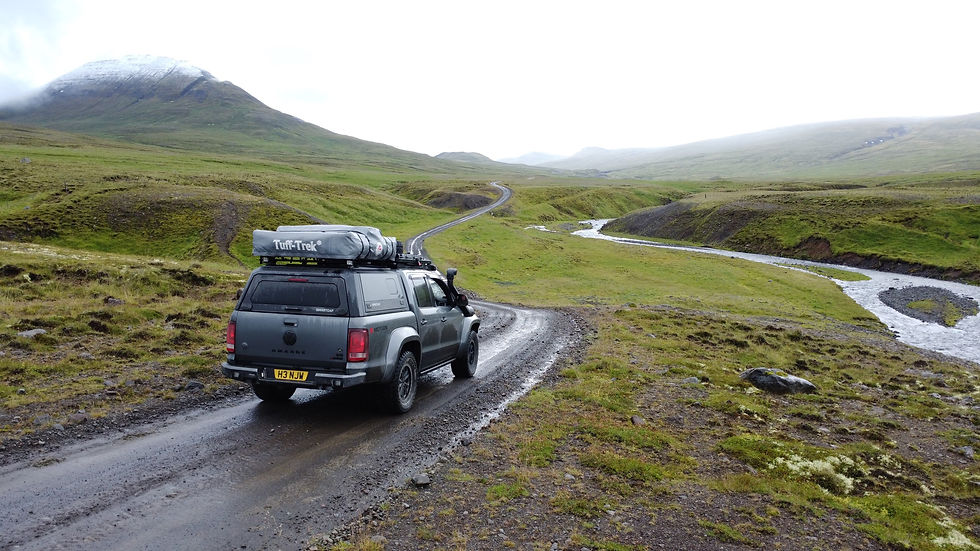
This isn’t what we brought Rocky to Iceland for and so we look at alternatives, some smaller F Roads and some un-named tracks – off we go!

Initially the scenery is rocky but green and mountainous with a couple of fertile valleys that are home to a number of farms.

After about 4 hours driving we reach the interior proper.

It is a desolate, bleak place with no settlements and very little life at all except for sheep – these sheep are not the coiffured ones we’ve seen so far on our trip, they are ragged and muddy and no wonder, life must be tough here.

We come across a group of wet and miseable looking riders who seem to be herding a group of loose ponies all in single file along a narrow track, it’s a surprise to see people (and horses for that matter) and we can’t imagine where they’ve come from or where on earth they’re headed.

As we drive on we begin to notice little flashes of colour on the otherwise grey ground and realise that there is some gentle beauty to be found here, not just the stark and immense magnificence of the plains.
We get out to look and find clusters of really pretty little plants clinging on here in the poor soil.
What an amazing day! Even the weather can’t detract from our enjoyment although it does its best – snow showers, sleet, rain and a cruel, biting wind. Luckily it's warm and dry inside Rocky.


We’ve taken the precaution today of wearing our thermal base layers and when we get out to explore, we are really glad we have!
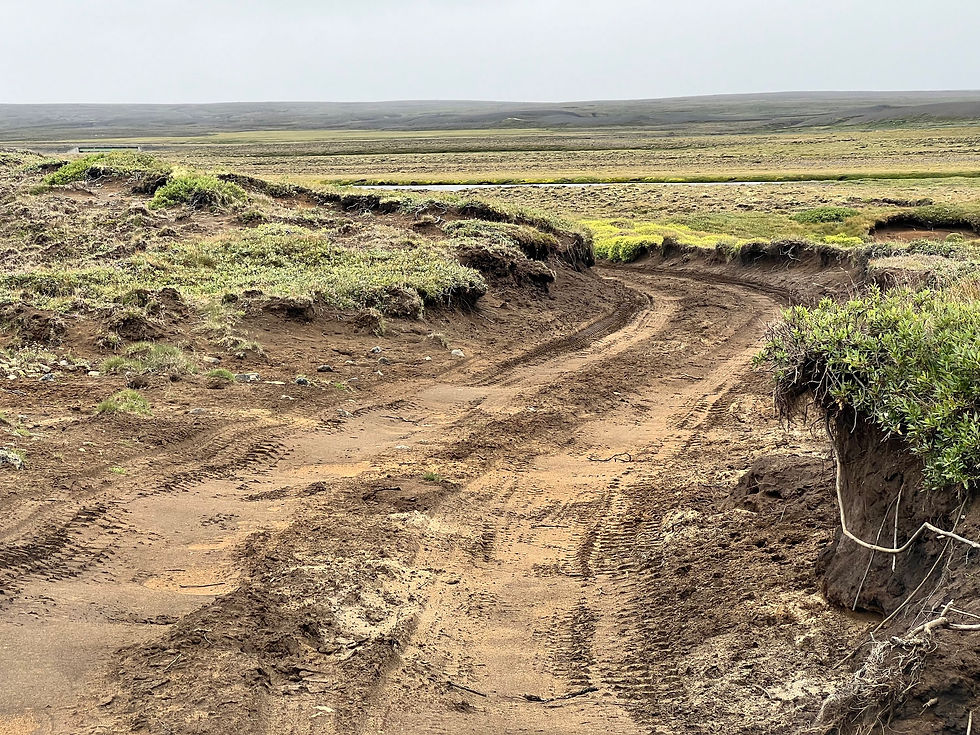
We travel down a mix of tracks - sandy, muddy and some with huge rocks in our way but Nick and Rocky handle them expertly!
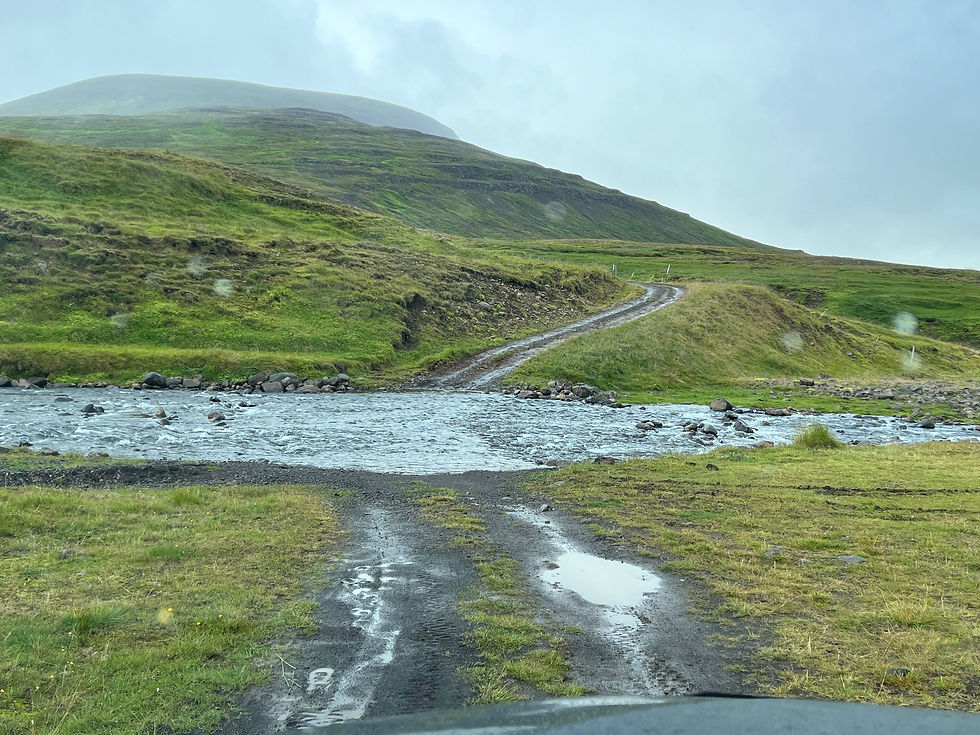
We cross some shallow rivers which are fun and then towards the end of our journey we drive over the brow of a hill and are faced with a river which is a very different beast, it is wide, it is fast flowing and it looks deep.
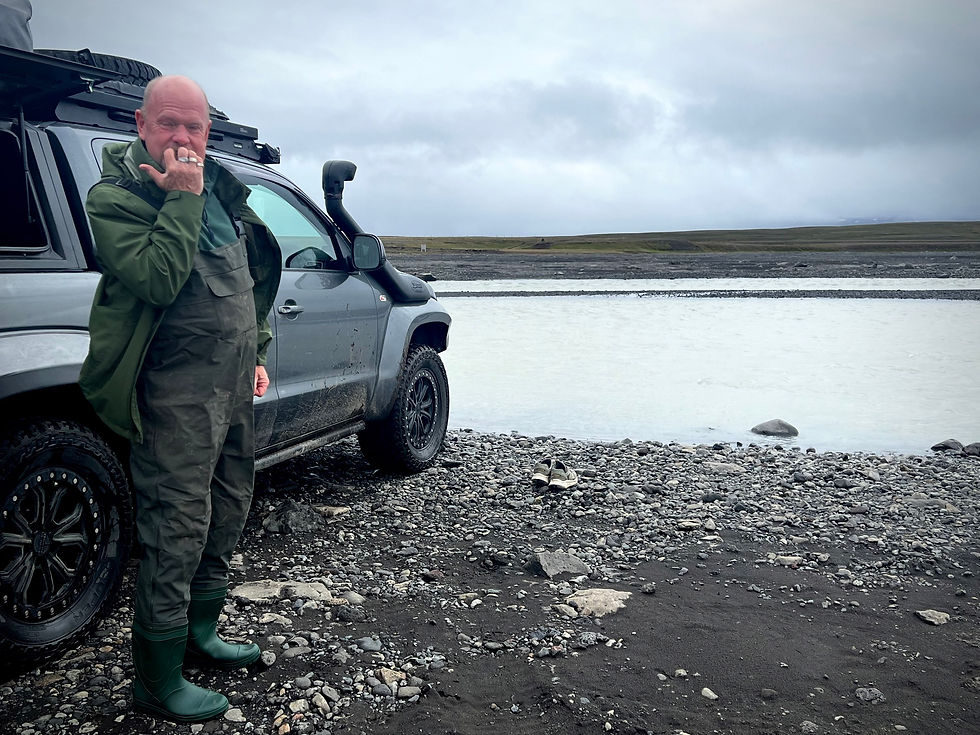

Despite the perishing wind, Janette decides that the only safe and sensible thing to do would be for Nick to don his waders and check the depth. Janette kindly offers to take photographs from the safety of the bank!
The water comes above Nick's knees in places but he feels it’ll be ok. Advice is to wait for another vehicle to come along but there’s little chance of that as we’ve seen maybe two other vehicles all day…

…so we set off and it is hair raising for sure but we make it in one piece!
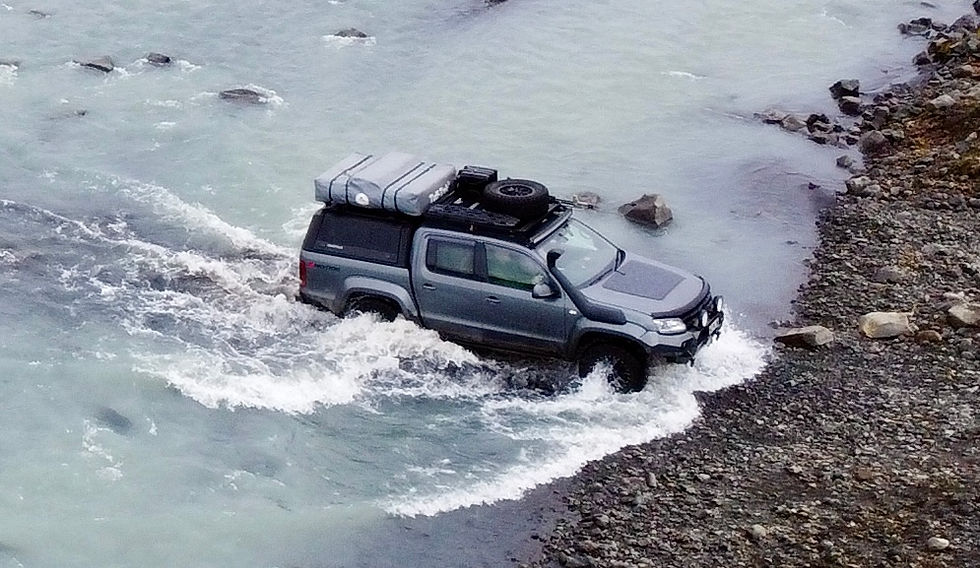
Our destination for tonight is the Iceland Touring Association camp at Hveravellir which is a geothermal nature reserve sitting between the glaciers of Langjokull and Hofsjokull.
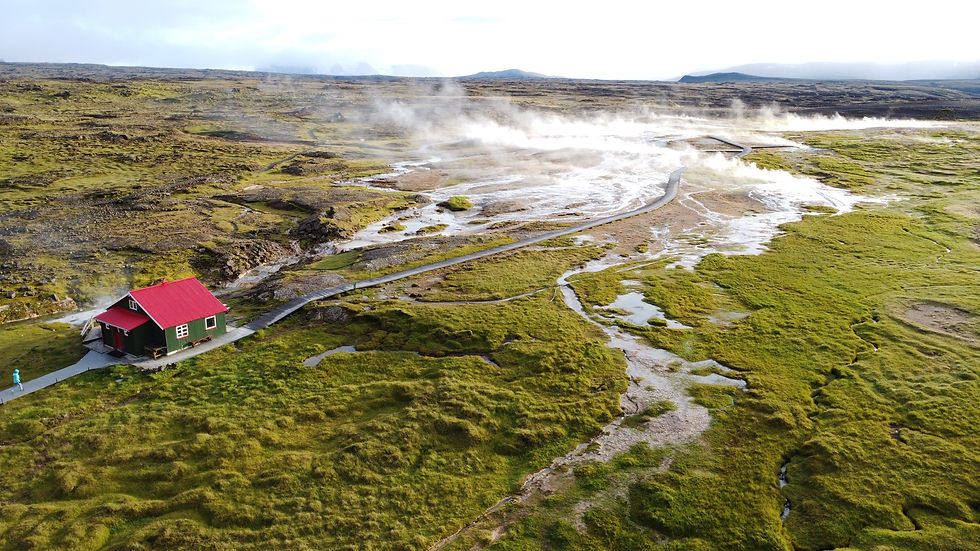
The camp sits at 650 metres above sea level and provides a hut, dorms and a camping area. A big bonus is that there is a hot pool here which is available to bathe in as well as bubbling mud and steaming water rising from the earth’s core.
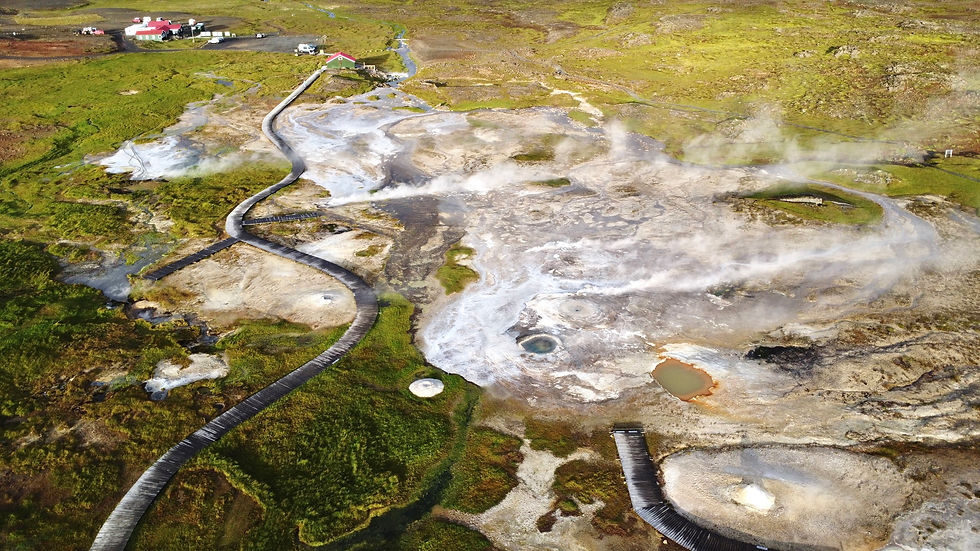
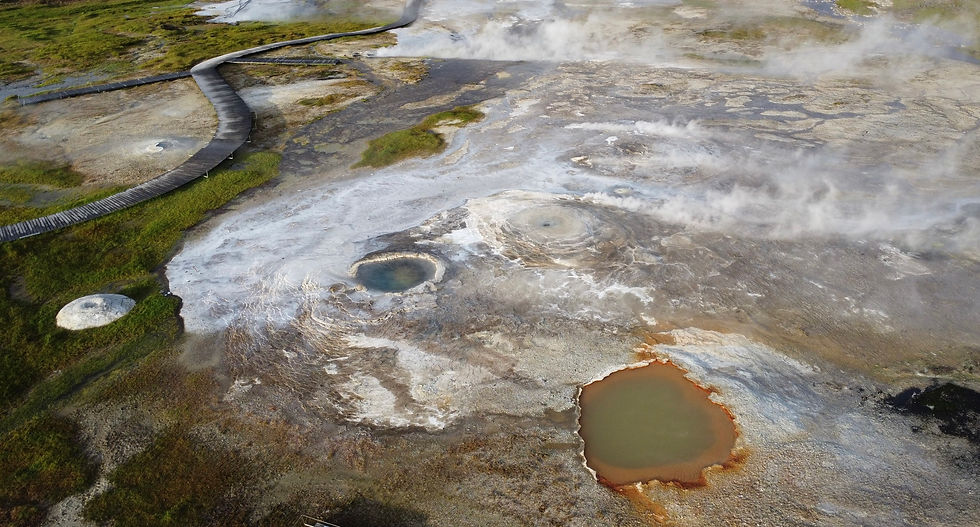
There is also a restaurant here where we can get dinner and breakfast which is very attractive as it’s still so cold and the snow showers keep coming.

We are however horrified to have to pay the equivalent of £65.00 for two halves of beer and two shepherds pies!
Nick gallantly sets up the tent while Janette skulks about in the restaurant trying to look busy…

.....and although the forecast is for a very cold night – freezing but feeling like minus 4 because of the wind, we are confident that we have enough bedding to keep us cosy - let's hope so!
We survive the night although there is a low point for Janette when she has to get up to go to the loo at 2 a.m. in the snow, she has a bit of a sense of humour failure!

The next morning it is still cold with a biting wind but undaunted we get into our swimsuits and head to the thermal bath. It is truly soul destroying to be standing in just our cossies in the freezing cold and dipping our toes into the water only to discover that it is far too hot, we can't possibly get in! There is some complicated process involving a pipe of the boiling spring water and another of cold water whereby the temperature can be regulated but that's beyond our pay grades so we return crestfallen, to the tent.
We go for a walk around the thermal field which we really enjoy, no tourists here just splendid solitude and wilderness as far as the eye can see.

We resume our journey and our first port of call is Kerlingarfjoll, a mountain range and geothermal area. The route tales us down another F Road; from the map, this looks to be just a track with four river crossings to negotiate and so we are surprised to see several other vehicles on the route.
The first river has been bridged, there is a waterfall with a viewpoint and so we imagine that this is the point where others will turn back. Not a bit of it, there is quite a bit of toing and froing of vehicles and all of the rivers have been bridged; we start to think that something is afoot......

We round a bend to be confromted with a sizeable new-looking resort, consisting of a posh hotel, cabins for rent and a camp ground, we weren't expecting that! We stop off in the hotel for coffee and then head on up the mountain.

The drive up to the thermal fields is steep and the scenery is right up there with the most dramatic we've seen; a river has carved a deep gorge in the surrounding rock, this is not the kind we've been used to seeing as most valleys are wide and U-shaped, carved by glaciers.

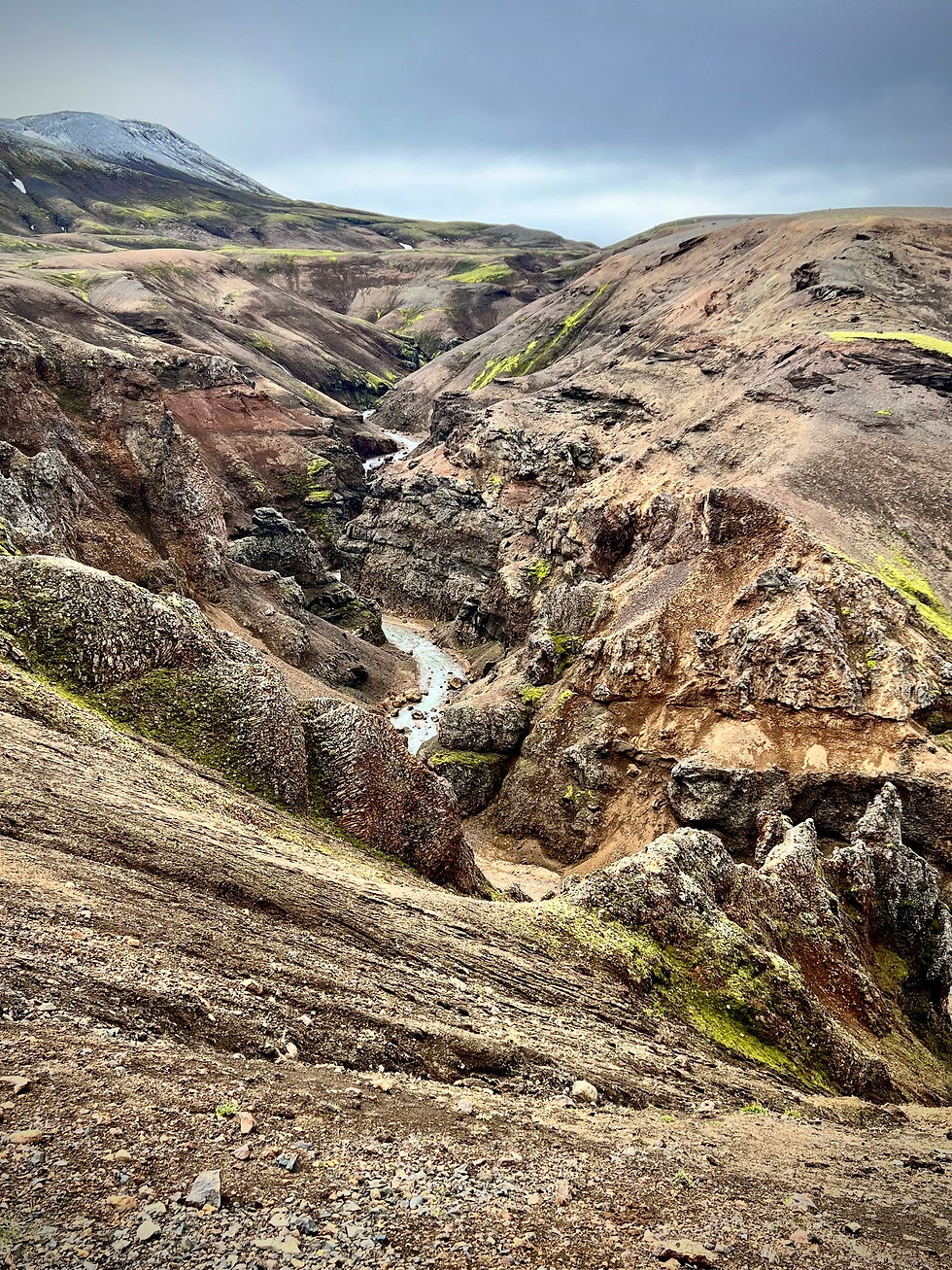
Nothing prepares us for what we see next, we can only gaze in wonder. This is a truly awe-inspirig sight. The weather is still brutal, it's cold and there's a fierce wind but this dramatic landscape calls for dramatic weather and we're glad we haven't come here when the weather is benign, it would have detracted from the impact this place has upon us.
There's such a contrast between the snow covered peaks and the hot geothermal area. Neither of us has ever seen anything like this before and it's one of the highlights of our trip so far.
Kerlingarfjoll was formed by subglacial volcanic activity over 300,000 years ago and the geothermal area is one of the largest in Iceland. The geology of the mountains consists mainly of rhyolite hence the array of colours - oranges, pinks and yellows it really is a sight to behold.

Sadly we aren't booking into the posh hotel, instead we need to keep heading south but we want to make one more detour before we look for somewhere to stay. We've seen some F Roads that appear to head out in the direction of the glacier to the west - Langjokull.
This F Road is certainly the road less travelled, it's rough, very rough in places and there is a smallish river to ford.
The terrain makes it slow going. There's a campsite icon on the map and we start to think that we may try to stay there overnight rather than re-tracing our steps today. When we eventually arrive, there is no sign of life and certainly no sign of any campsite, just a sweet little mountain hut completely alone in the wilderness.

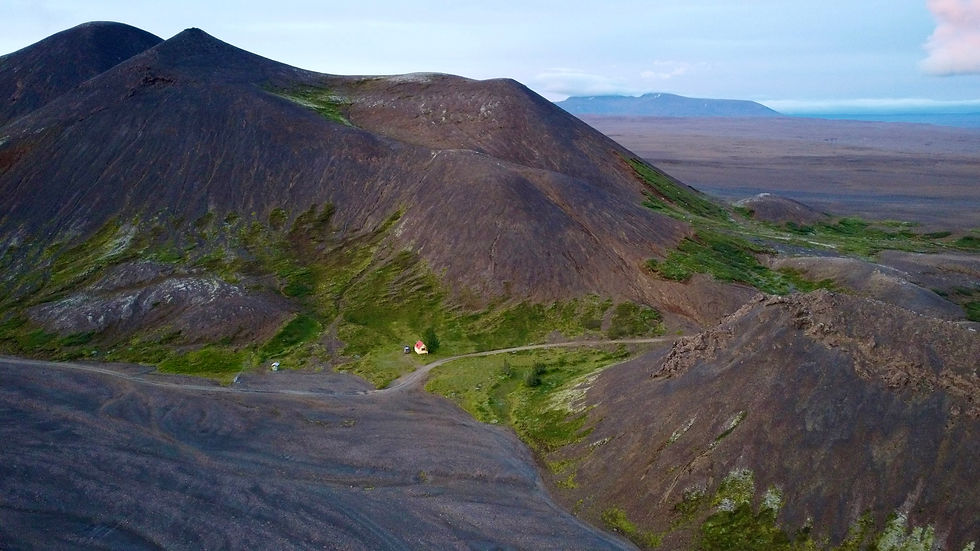
Nick goes to investigate and we discover that it is an Iceland Touring Association hut that it's possible to stay in overnight. It's lovely, there is a wood burning stove and we are soon snug and sheltered from the cold wind which is still blowing a hoolie outside.
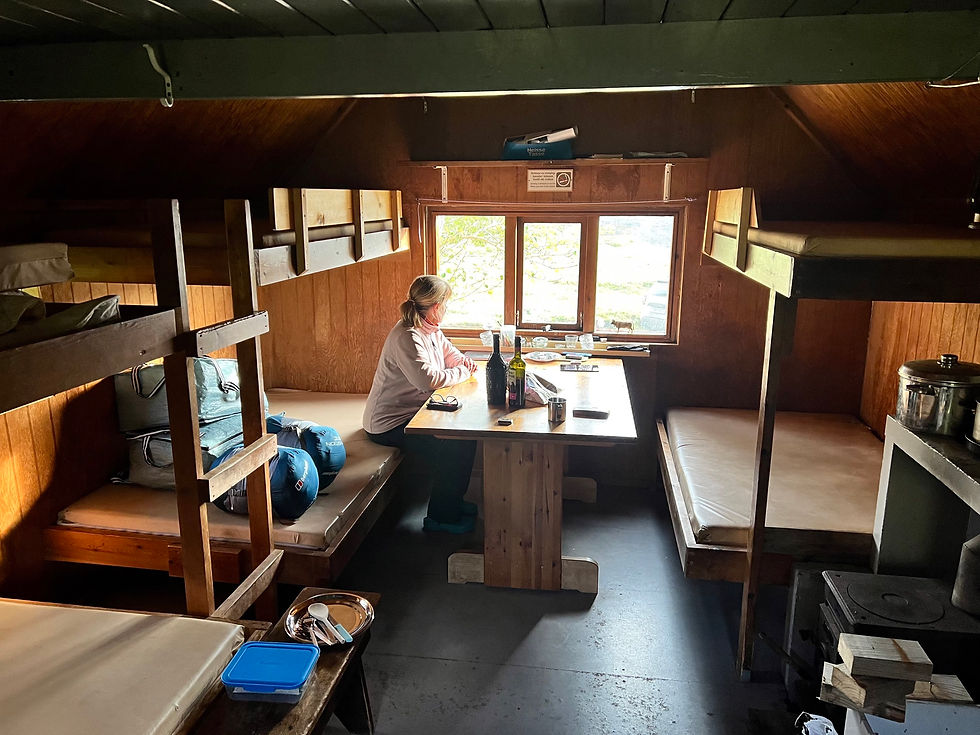
We cook dinner and settle in for the night hoping that no other guests show up, we want the place to ourselves and we are lucky, no one else arrives.
The morning dawns bright and sunny and the wind has dropped. We have noticed that the track continues for a distance and that there is an enormous waterfall at the end of the valley, so we set off to explore.
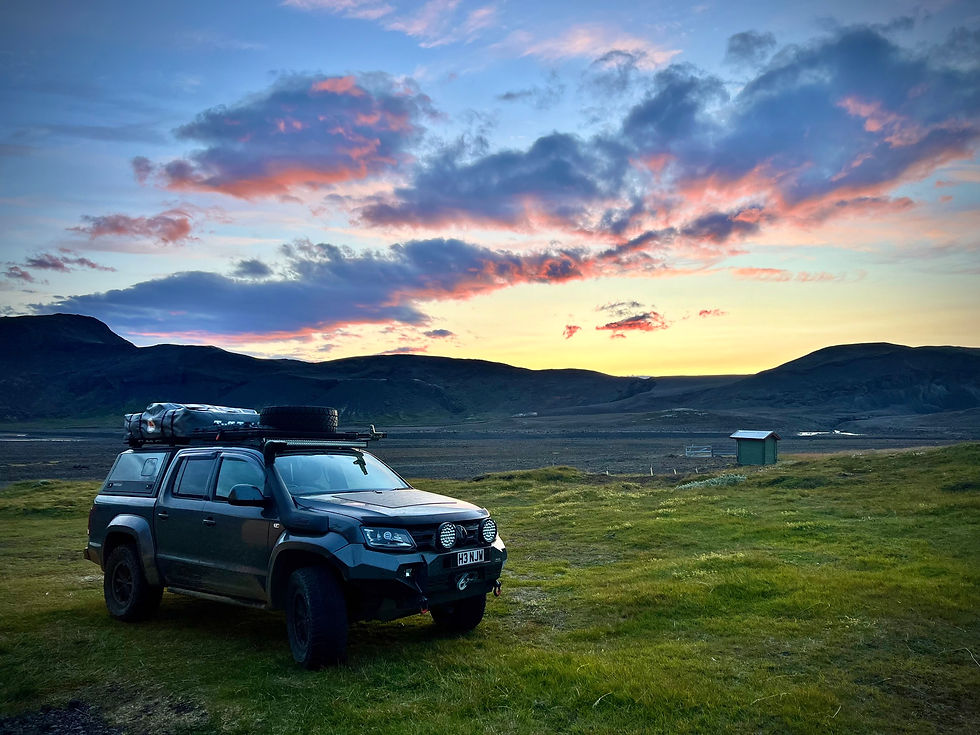

The waterfall is certanly impressive, falling down over several tiers. We climb to the top on a shaley path that at times goes perilously close to the edge; Janette isn't great with heights and this is almost more than she can tolerate, for her it's really scary.
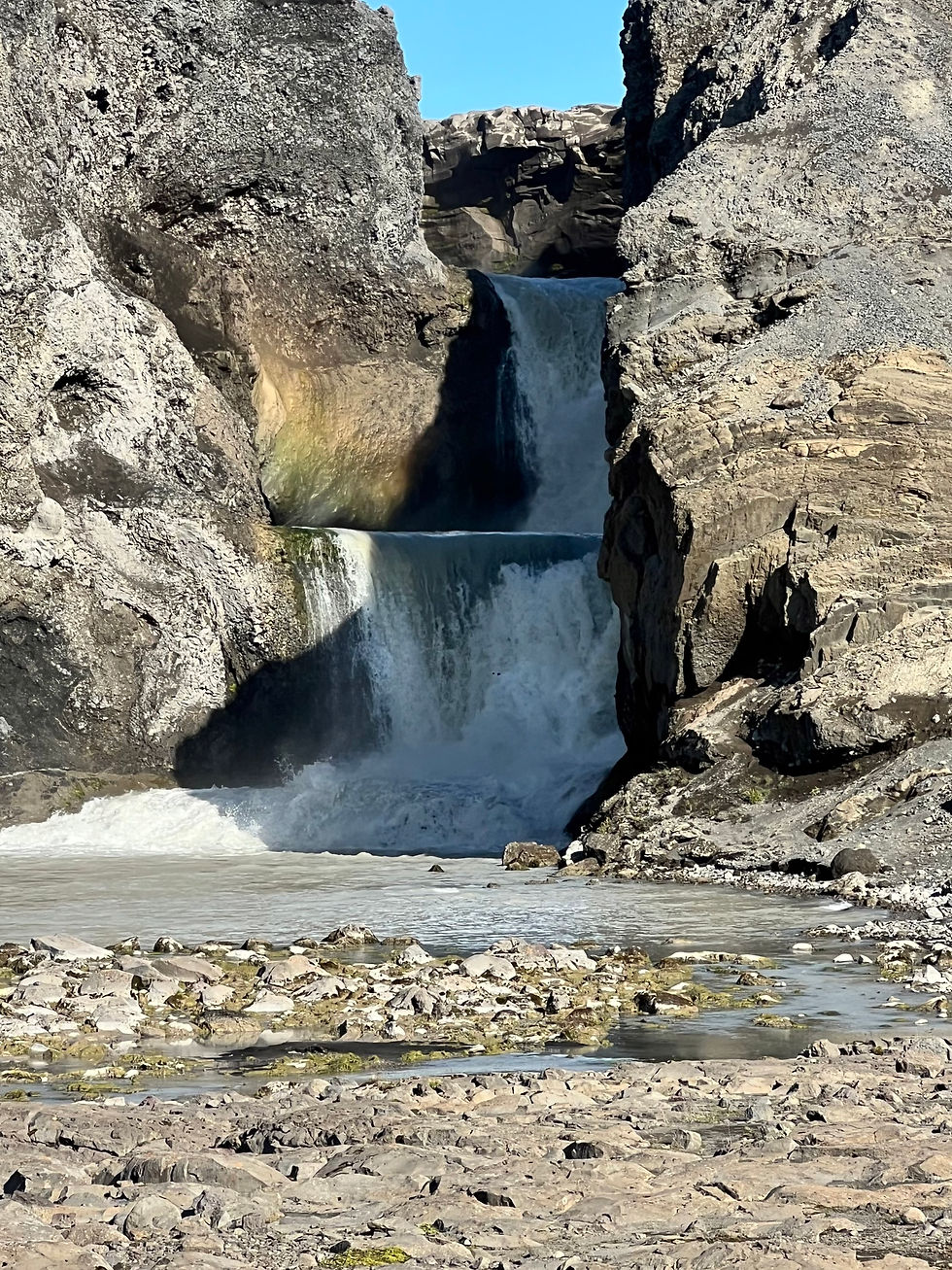
Making it to the top and seeing the glacial lake which feeds the waterfall makes the terror of the climb a price worth paying. Everything is still and utterly silent except for the sound of the water cascading down to the valley below.
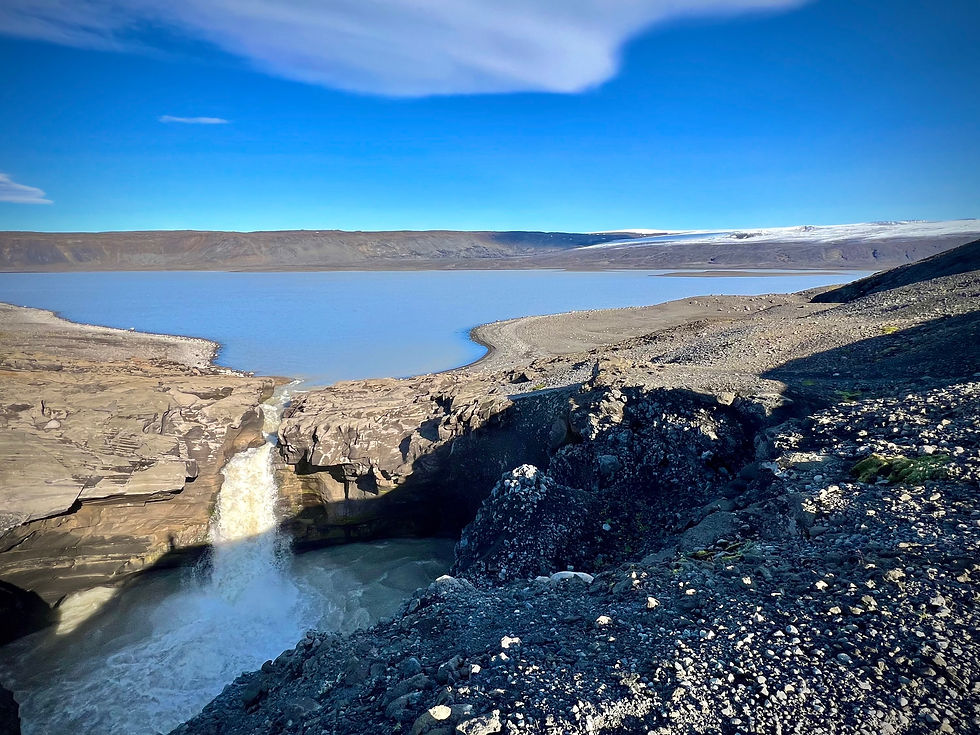
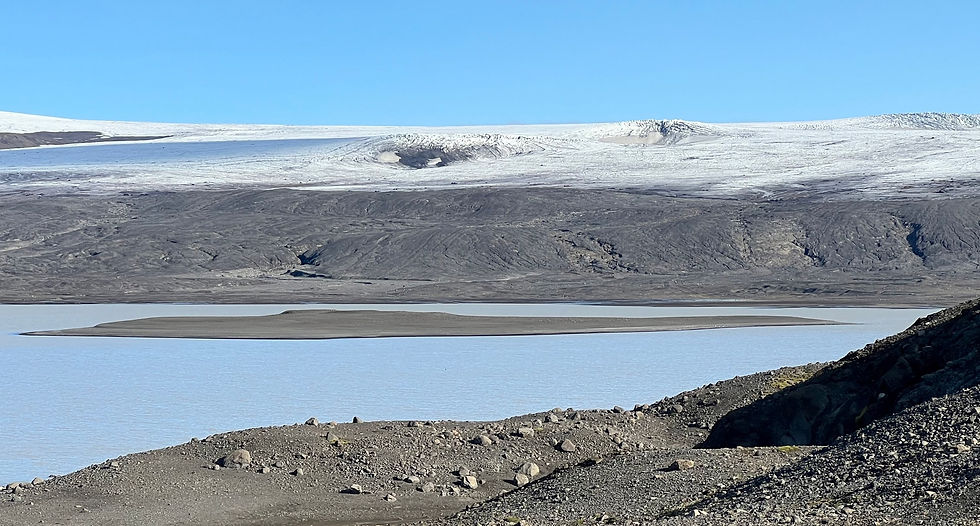
No danger of this being a tourist hotspot, we don't see another soul.

We leave behind this idyllic place and start to head into civilisation. We are spending a couple of nights in a hotel in Reykjavik but before we get there, as we are passing we are going to visit three of the big hitters on what is known as Iceland's Golden Circle - Gulfoss, Geysir and Thingvellir.
First stop Gulfoss. As we approach and see the car park full of tourist coaches, our first impressions are that this is going to be ghastly - but we decide to persevere on the basis that these sights don't get to be this popular unless they are really spectacular and we aren't wrong! This waterfall tops them all, the sheer might of the water rushing over the falls is jaw dropping.

The Hvita River flows from the Langjokull Glacier and the average flow, which occurs in summer, is 140 cubic metres per second although when in flood, a flow rate as high as 2,000 cubic metres per second has been recorded - this is the equivalent of 15,000 bath tubs of water per second, that's 54 million bath tubs per hour!
As the water crashes over the falls, it enters a canyon which turns abruptly to the left and the water is forced to follow it, it really is something to see!
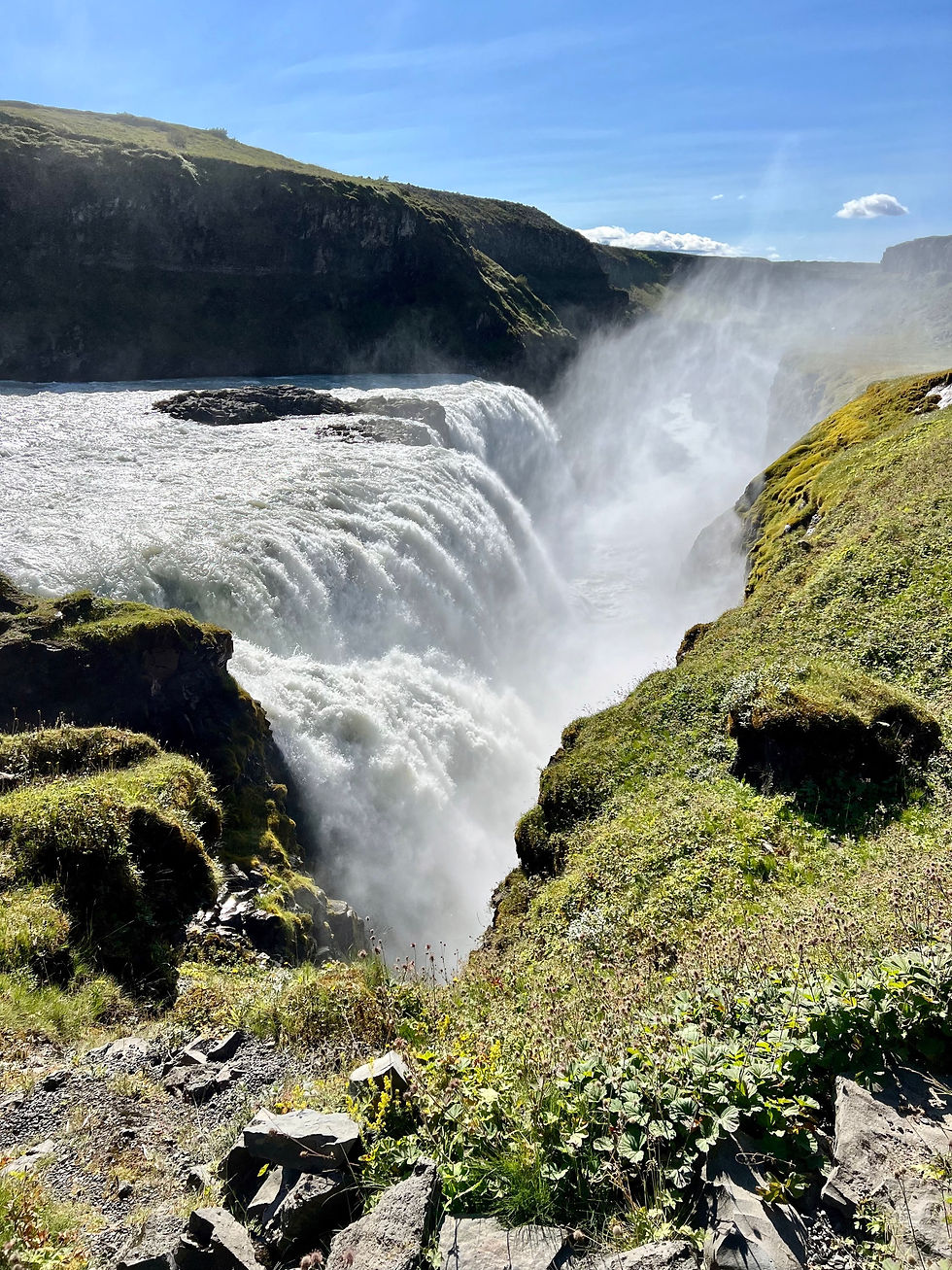
Next stop - Geysir and yes, it's heaving with tourists too!
A geyser is formed from a tube-like hole running deep down into the Earth's crust. Water fills the hole and encounters molten magma at the bottom which boils the water, the steam creates pressure and intermittently the water shoots up into the air.
Geysir, after which all geysers take their name, has stopped erupting but its neighbour Strokkur has picked up the baton and every few minutes treats onlookers to an impressive show.

Poor old Rocky is in a dreadfully dirty state, not only have we been through rivers and mud but as we drive along mountain tracks and F Roads his tyres cause clouds of fine volcanic dust to rise and he is literally covered in filth. Time for a bath!

As we travel along towards the final of our three sightseeing stops, we see fellow travellers who have somehow managed to tip their vehicle over. There's no obvious reason for it, they haven't come off the road, maybe a tyre blow out we think.
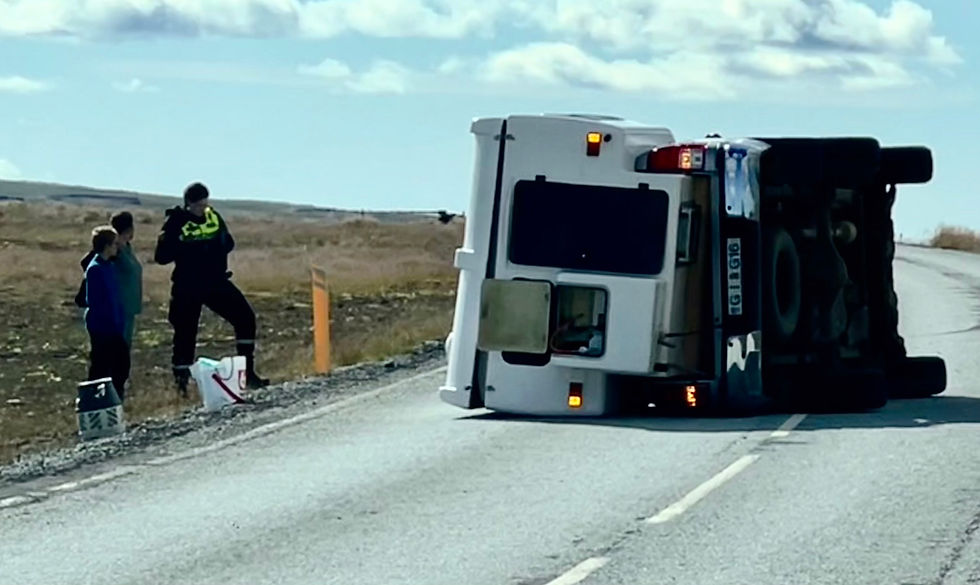
Final stop and surprisingly much less busy given it's UNESCO World Heritage Site status and the fact that it was a filming location for Game of Thrones, is Thingvellir. This is where the North American and Eurasian tectoninc plates meet and are moving apart at a rate of 2 cm per year!


Janette is supposed to be pushing the plates apart in this photo... not holding up the traffic!
Not only is this a place of great beauty and geological significance it also plays a huge part in the history of Iceland and is considered by many Icelanders as a sacred place, a waymark in their heritage. In 930 AD Iceland's democratic parliament, one of the first in the world was founded here and continued to meet here until 1798. In 1,000 AD Iceland's conversion to Christianity was declared here.

Then we head to Reykjavik and oh goodness it seems that all of the population of Greater Reykjavik - approximately 240,000 people - have taken to their cars! There are traffic jams everywhere we are dumbfounded, this isn't what we were expecting at all and we don't like it!
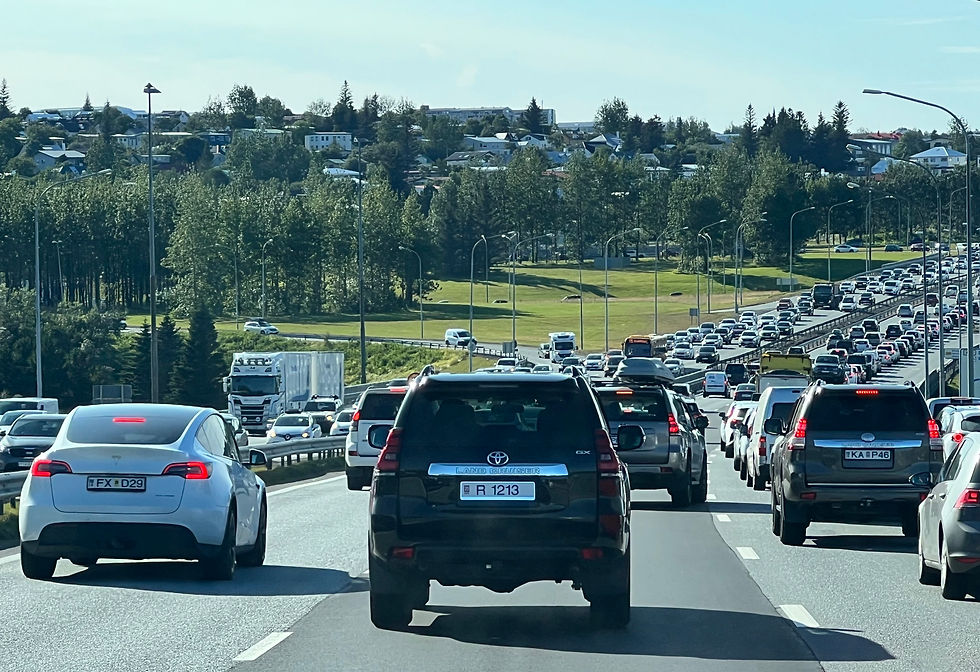
We have visited Reykjavik briefly once before and we are looking forward to exploring further, we'll let you know how we get on in our next blog... watch this space!





























It looks absolutely incredible, so amazing to see the places I also visited without any snow, it looks so different! Xx
Loving this latest adventure. Such beautiful and dramatic scenery. Enjoy the volcano 🌋 xx